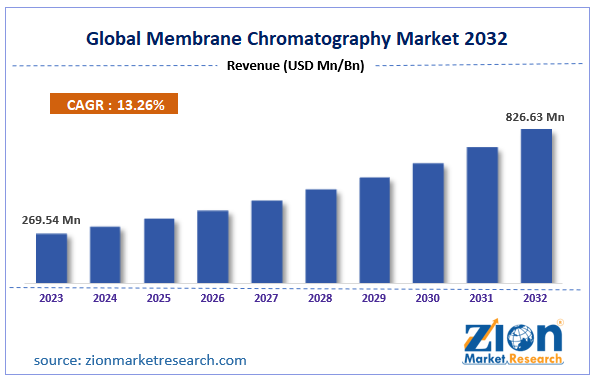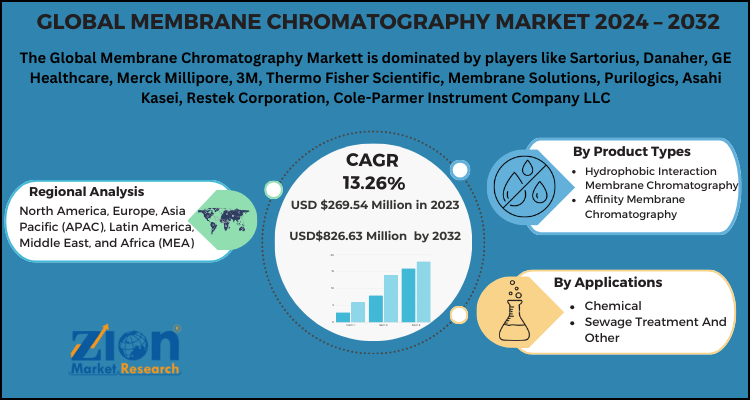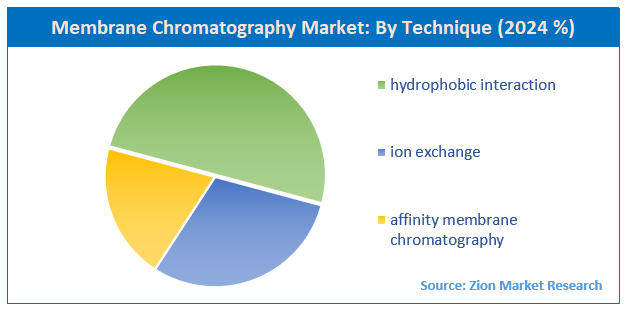Membrane Chromatography Market Trend, Share, Growth, Size and Forecast 2032

Membrane Chromatography Market By Product (consumables and accessories), By Technique (hydrophobic interaction, ion exchange, and affinity membrane chromatography), By Operation (bind-elute membrane and flow-through chromatography), By end-users (academic & research institutes, CROs, and pharmaceutical & biopharmaceutical companies) and By Region: Global Industry Analysis, Size, Share, Growth, Trends, and Forecast 2024-2032
| Market Size in 2023 | Market Forecast in 2032 | CAGR (in %) | Base Year |
|---|---|---|---|
| USD 269.54 million | USD 826.63 million | 13.26% | 2023 |
Description
The global membrane chromatography market size accrued earnings worth approximately USD 269.54 Million in 2023 and is predicted to gain revenue of about USD 826.63 Million by 2032, is set to record a CAGR of nearly 13.26% over the period from 2024 to 2032
Key Insights:
- As per the analysis shared by our research analyst, the membrane chromatography market is anticipated to grow at a CAGR of 13.26% during the forecast period (2024-2032).
- The global membrane chromatography market was estimated to be worth approximately USD 269.54 billion in 2023 and is projected to reach a value of USD 826.63 billion by 2032.
- The growth of the membrane chromatography market is being driven by increasing adoption in biopharmaceutical manufacturing and research applications.
- Based on the product, the consumables segment is growing at a high rate and is projected to dominate the market.
- On the basis of technique, the hydrophobic interaction segment is projected to swipe the largest market share.
- In terms of operation, the bind-elute membrane segment is expected to dominate the market.
- Based on the end-users, the academic & research institutes segment is expected to dominate the market.
- By region, North America is expected to dominate the global market during the forecast period.
Global Membrane Chromatography Market: Overview
In Global Membrane Chromatography Market Report, Membrane chromatography is a bioseparation technology used to integrate liquid chromatography and membrane filtration into a single-stage operation. The advancements in membrane chemistry have facilitated novel membrane devices with improved mass transfer and high binding capacities. It has significantly lowered the downtime in bioprocessing costs owing to the reduced equipment costs, low buffer consumption, and disposable nature. This technology is used to capture or bind the large particles like virus vector & virus, hold cell protein impurity, and polishing steps to remove DNA. It is a quick and innovative technology utilized in the production of drugs and facilitates higher capturing productivity and efficiency as compared to other chromatography techniques. The isolation process of protein & enzymes, further purification, and several other biotechnology-related applications are efficiently carried by membrane chromatography.
Global Membrane Chromatography Market: Growth Factors
The biopharmaceutical sector is increasingly adopting disposable technologies such as disposable modules for chromatography. This has reduced the concern regarding hazardous environmental impact due to the solid plastic waste produced from their usage. Disposable membrane chromatography has highly reduced the demand for water load. The hydrodynamic benefit has reduced the total process time, energy consumption, and labor management. Hence these factors boost the growth of the global membrane chromatography market.
The growing benefits of innovative methods by membrane chromatography over other conventional methods are driving the growth of the global membrane chromatography market. Membrane chromatography is used and adopted only in niche applications like the elimination of dilute impurities like endotoxins, viruses, and DNA. Moreover, the method is highly used as a polishing step in commercial processes to generate monoclonal antibody therapeutics. In the biopharmaceutical sector, downstream processing is fully dependent on membrane chromatography technology. The increasing scrutiny regulation on cleaning validation of the downstream purification process further bolsters the global membrane chromatography market. The growing investments in research and development of membrane chromatography further fuel the market growth globally.
Recent Development
- In July 2025, Purilogics, a Donaldson Life Sciences company, launched its first manufacturing-grade membrane chromatography product, Purexa™ NAEX, marking the integration of Purilogics’ technology, acquired by Donaldson in June 2022, into its bioprocessing portfolio.
- In September 2024, Sartorius introduced Vivaflow Tangential Flow Filtration Cassettes, designed to streamline ultrafiltration and diafiltration in labs, boosting efficiency while lowering operational costs and user effort.
- In June 2024, Asahi Kasei launched a membrane system for producing water for injection, improving water quality while lowering CO2 emissions and production costs compared to traditional distillation methods.
Membrane Chromatography Market: Report Scope
| Report Attributes | Report Details |
|---|---|
| Report Name | Membrane Chromatography Market |
| Market Size in 2023 | USD 269.54 Million |
| Market Forecast in 2032 | USD 826.63 Million |
| Growth Rate | CAGR of 13.26% |
| Number of Pages | 200 |
| Key Companies Covered | Sartorius, Danaher, GE Healthcare, Merck Millipore, 3M, Thermo Fisher Scientific, Membrane Solutions, Purilogics, Asahi Kasei, Restek Corporation, Cole-Parmer Instrument Company LLC, Starlab Scientific Co. Ltd, Koch Membrane Systems Inc, NATRIX Separations Inc, GVS Group, BÜCHI Labortechnik AG, TORAY INDUSTRIES, CITIC Envirotech, and Pall Corporation. |
| Segments Covered | By Product, By technique, By operation, By end-user and By Region |
| Regions Covered | North America, Europe, Asia Pacific (APAC), Latin America, Middle East, and Africa (MEA) |
| Base Year | 2023 |
| Historical Year | 2018 to 2022 |
| Forecast Year | 2024 - 2032 |
| Customization Scope | Avail customized purchase options to meet your exact research needs. Request For Customization |
Global Membrane Chromatography Market: Segmentation
The global membrane chromatography market can be segmented into product, technique, end-users, and region.
By Product, the market can be segmented into consumables and accessories. The consumables segment holds the largest share in the global membrane chromatography market. The consumables segment can be further bifurcated into membrane discs & sheets, spin columns, filter plates, syringe filters, and capsules, cassettes, & cartridges. The capsules, cassettes, & cartridges segment accounts for the largest share owing to the growing use of cartridges and capsules for purification applications in lab-scale production, biomanufacturing, and process development.
By Technique, the market can be segmented into hydrophobic interaction, ion exchange, and affinity membrane chromatography. The ion exchange membrane chromatography segment holds hegemony over others due to associated advantages like precision, speed, high selectivity, accuracy, and reliability. The ion exchange membrane chromatography segment can be further bifurcated into anion and cation exchange membrane chromatography.
By Operation, the market can be segmented into bind-elute membrane and flow-through chromatography.
The flow-through chromatography segment accounts for the largest share in the global membrane chromatography market due to the extensive adoption of this operation in monoclonal antibody polishing process owing to the reduced mass transfer, high flow rate, elimination of packaging costs, lower buffer consumption, and low cleaning column costs.
By End-user, the market can be segmented into academic & research institutes, CROs, and pharmaceutical & biopharmaceutical companies.
The pharmaceutical & biopharmaceutical companies segment holds domination over others due to the increasing research and development activities.
Membrane Chromatography Market Dynamics
Key Growth Drivers
The Membrane Chromatography Market is experiencing significant growth, primarily driven by the expanding biopharmaceutical industry and the increasing demand for efficient and cost-effective purification processes for biologics. As the prevalence of chronic diseases rises, so does the demand for complex biopharmaceuticals like monoclonal antibodies, vaccines, and gene therapies, all of which require highly pure and safe end products. Membrane chromatography, which offers advantages such as higher throughput, faster processing times, and scalability compared to traditional resin-based column chromatography, is ideally suited to meet this demand. The trend towards single-use technologies in bioprocessing also fuels the market, as disposable membrane chromatography systems reduce the risk of cross-contamination and lower operational costs by eliminating the need for cleaning and validation.
Restraints
Despite its advantages, the membrane chromatography market faces several significant restraints. The high initial cost of membrane chromatography systems and their consumables can be a major barrier for small-scale biopharmaceutical companies and research institutions with limited budgets. Although these systems can offer long-term cost savings, the considerable upfront investment can hinder wider adoption. Another key restraint is the limited use of membrane chromatography in large-scale manufacturing for certain applications. While highly effective for polishing and impurity removal, some large-scale processes still rely on traditional chromatography techniques due to technical limitations and the entrenched nature of existing workflows, which can slow down the market's growth in this segment.
Opportunities
The membrane chromatography market is presented with significant opportunities for innovation and expansion. The increasing focus on cell and gene therapies, which require highly specific and efficient purification of viral vectors and other biological components, is a major growth avenue. The market also has a strong opportunity in the rising trend of biopharmaceutical outsourcing to contract manufacturing organizations (CMOs) and contract research organizations (CROs). These organizations are increasingly adopting advanced and scalable technologies to meet the diverse needs of their clients, thereby driving the demand for membrane chromatography systems. Additionally, advancements in membrane materials and ligand chemistry are leading to the development of new, high-performance products with enhanced binding capacity and selectivity.
Challenges
The membrane chromatography market faces several complex challenges. One of the primary technical challenges is membrane fouling and degradation, which can reduce the lifespan and efficiency of the filters and increase operational costs. The market is also highly competitive and fragmented, with a large number of global and regional players, which can lead to pricing pressures and a race to innovate. The need for a skilled workforce with specialized knowledge in bioprocessing and membrane chromatography is a significant hurdle for many companies. Lastly, the stringent and constantly evolving regulatory scrutiny on the cleaning validation of downstream purification processes can pose a challenge, as manufacturers must ensure their systems meet rigorous quality and safety standards to avoid non-compliance and product recalls.
Global Membrane Chromatography Market: Regional analysis
North America holds the largest share in the global membrane chromatography market due to the growing demand for biopharmaceuticals, increasing investments in research & development activities, and the presence of prominent players in the region.
Asia Pacific is also expected to grow significantly during the forecast period due to the growing government support, improving health infrastructure, and increasing investments in the region.
Global Membrane Chromatography Market: Competitive Players
Some of the significant players in the global membrane chromatography market are
- Sartorius
- Danaher
- GE Healthcare
- Merck Millipore
- 3M
- Thermo Fisher Scientific
- Membrane Solutions
- Purilogics
- Asahi Kasei
- Restek Corporation
- Cole-Parmer Instrument Company LLC
- Starlab Scientific Co. Ltd
- Koch Membrane Systems Inc
- NATRIX Separations Inc
- GVS Group
- BÜCHI Labortechnik AG
- TORAY INDUSTRIES
- CITIC Envirotech
- and Pall Corporation.
Global Membrane Chromatography Market: Regional Segment Analysis
By Product
- Consumables and
- Accessories
By Technique
- Hydrophobic interaction
- Ion Exchange
- Affinity Membrane Chromatography
By Operation
- Bind-Elute Membrane
- Flow-Through Chromatography
By End-Users
- Academic & Research Institutes
- CROs
- Pharmaceutical & Biopharmaceutical Companies
By Region
- North America
- The U.S.
- Canada
- Europe
- France
- The UK
- Spain
- Germany
- Italy
- Rest of Europe
- Asia Pacific
- China
- Japan
- India
- South Korea
- Southeast Asia
- Rest of Asia Pacific
- Latin America
- Brazil
- Mexico
- Rest of Latin America
- Middle East & Africa
- GCC
- South Africa
- Rest of Middle East & Africa
What Reports Provides
- Full in-depth analysis of the parent market
- Important changes in market dynamics
- Segmentation details of the market
- Former, on-going, and projected market analysis in terms of volume and value
- Assessment of niche industry developments
- Market share analysis
- Key strategies of major players
- Emerging segments and regional markets
- Testimonials to companies in order to fortify their foothold in the market.
Table Of Content
FrequentlyAsked Questions
The biopharmaceutical sector is increasingly adopting disposable technologies such as disposable modules for chromatography. This has reduced the concern regarding hazardous environmental impact due to the solid plastic waste produced from their usage. Disposable membrane chromatography has highly reduced the demand for water load.
Some of the significant players in the global membrane chromatography market are Purilogics LLC, Restek Corporation, Asahi Kasei Corporation, Sartorius AG, Cole-Parmer Instrument Company, LLC, 3M, Starlab Scientific Co., Ltd, GENERAL ELECTRIC, Merck KGaA, Danaher, Koch Membrane Systems Inc, Thermo Fisher Scientific Inc., NATRIX Separations, Inc, GVS Group, Restek Corporation, Cole-Parmer Instrument Company, LLC, Merck Millipore, BÜCHI Labortechnik AG, TORAY INDUSTRIES, CITIC Envirotech, and Pall Corporation.
Which region will make notable contributions towards overall membrane chromatography market revenue?
North America holds the largest share in the global membrane chromatography market due to the growing demand for biopharmaceuticals, increasing investments in research and development activities, and the presence of prominent players in the region.
Based on statistics from the Zion Market Research, the global Membrane Chromatography Market size was projected at approximately US$ 269.54 Million in 2023. Projections indicate that the market is expected to reach around US$ 826.63 Million in revenue by 2032.
The global Membrane Chromatography Market is expected to grow at a Compound Annual Growth Rate (CAGR) of around 13.26% during the forecast period from 2024 to 2032.
The global Membrane Chromatography Market report provides a comprehensive analysis of market definitions, growth factors, opportunities, challenges, geographic trends, and competitive dynamics.
HappyClients
Zion Market Research
Tel: +1 (302) 444-0166
USA/Canada Toll Free No.+1 (855) 465-4651
3rd Floor,
Mrunal Paradise, Opp Maharaja Hotel,
Pimple Gurav, Pune 411061,
Maharashtra, India
Phone No +91 7768 006 007, +91 7768 006 008
US OFFICE NO +1 (302) 444-0166
US/CAN TOLL FREE +1 (855) 465-4651
Email: sales@zionmarketresearch.com
We have secured system to process your transaction.
Our support available to help you 24 hours a day, five days a week.
Monday - Friday: 9AM - 6PM
Saturday - Sunday: Closed







